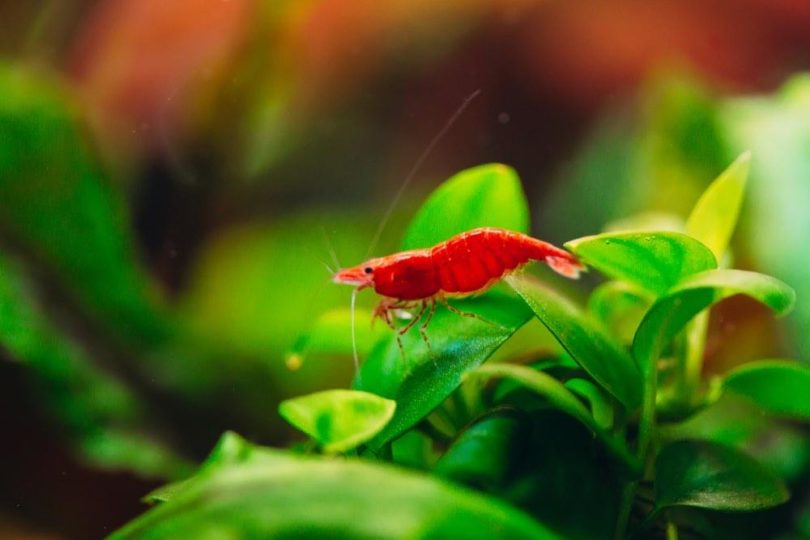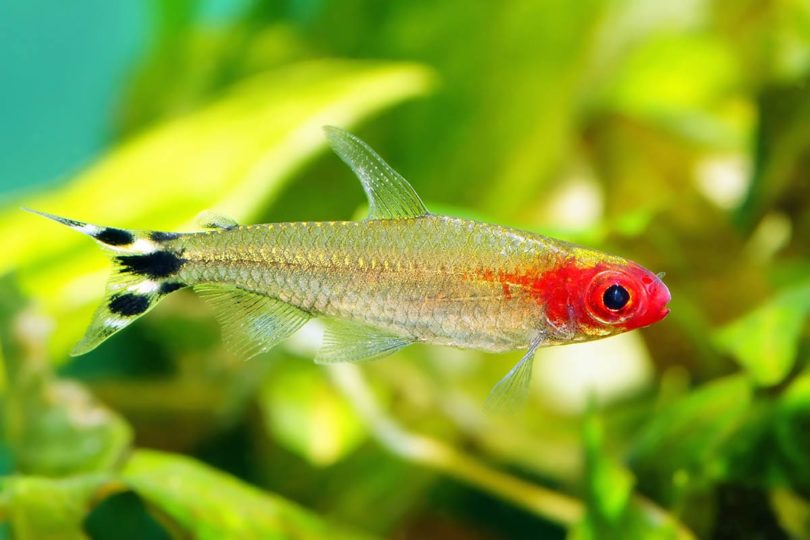Why Are My Aquarium Plants Turning Brown? 6 Reasons & Solutions
Updated on
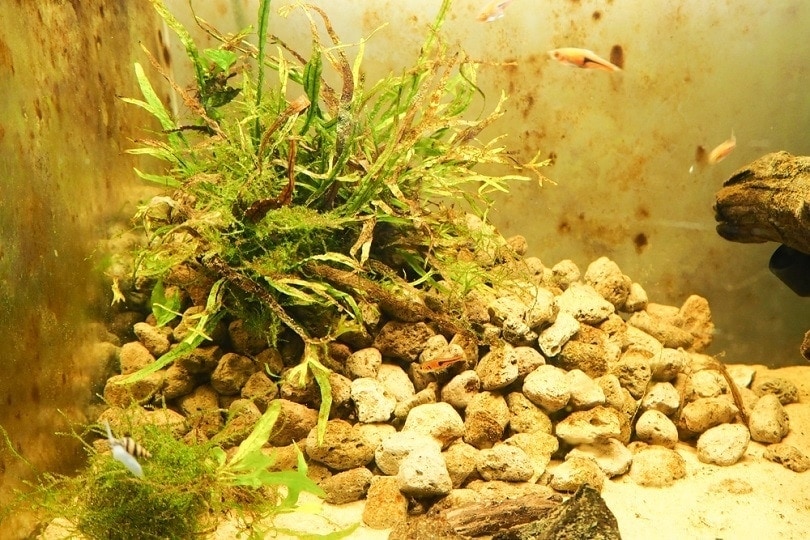
Plants make any aquarium look lively and add color, while also being beneficial for the aquarium life. Looking after your aquarium plants takes work and effort, much like when caring for fish. However, aquarium plants don’t always stay green and vibrant, and they may begin turning brown, making the aquarium look unsightly.
If this is an issue you are facing, we have compiled a list of the most common reasons for aquarium plants turning brown and how you can fix it.

The 6 Reasons Why Your Aquarium Plants Are Turning Brown
1. Nutrient Deficiencies
Plants require nutrients to grow, and this is no exception for aquatic plants. You may think that by putting your plant in an aquarium you won’t need to give the plant any care, but this is not true. You still need to ensure your plant is receiving enough minerals to grow and remain healthy, or it will begin suffering from a nutrient deficiency.
Your plants require both macronutrients (calcium, carbon, potassium, and nitrogen) and micronutrients (zinc, iron, and boron) which can be found in small traces in the aquarium water or substrates for planted aquariums. Brown leaves are usually a sign that your aquarium plants are lacking phosphate, a macronutrient.
Plants won’t get all their nutrients from the aquarium, and this is where a good aquatic plant fertilizer will come in handy. It is best to choose a fertilizer that contains both macronutrients and micronutrients, as some fertilizers only consist of one type of nutrient for plants. If your aquarium plants are not in a nutritive-rich soil, like gravel, you will need to supplement the water with fertilizers or use a good root tab in the substrate that the plants are in.
If you have invertebrates such as shrimp or snails in an aquarium, make sure that the fertilizer you are using is safe for them.
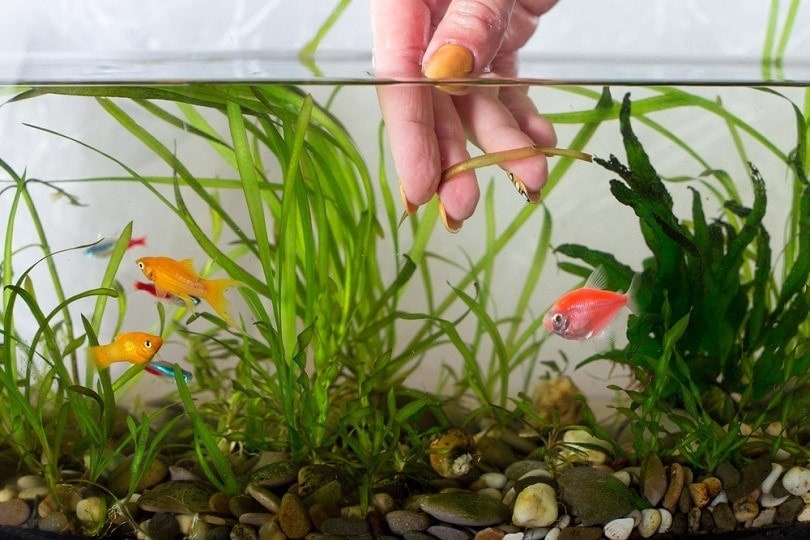
2. Too little Light
Plants need light for photosynthesis which helps them to grow, make their food, and stay healthy. This is no exception for aquatic plants that require light over the aquarium to grow. By keeping your aquarium plants in darkness or only relying on light from a window, they will begin to turn brown from a lack of good lighting.
In some cases, other aquarium plants may block the lower plants’ lighting, which will result in the bottom plants receiving less lighting than others. Algae can also cover the leaves of the plant, which blocks out essential lighting from reaching the leaves surface.
In planted aquariums, make sure that the aquarium has an overhead LED light that is bright enough to reach each plant in the aquarium. Depending on the types and number of plants you have in the aquarium, you will only need a moderately bright light.
You should leave the light on for 8 to 10 hours per day and switch all lighting off (even blue LED lighting) at night to give both the plants and aquarium inhabitants a period of darkness.
3. High Ammonia Levels
Poor water quality in an aquarium won’t only affect your fish, but also any live plants in an aquarium. This is a common reason for aquarium plants to turn brown, yellow, or black and some plants will even begin to die off and “melt” in the water. Although nitrate is beneficial to plants and they use it for nutrients and growth, high levels of ammonia, high temperatures, and the wrong pH can create an unideal environment for your plants to grow.
High levels of ammonia can burn your plant while being dangerous for fish. Aquarium plants can withstand a higher level of ammonia in the water than your fish and invertebrates, but soon the poor water quality will harm the plant’s growth and health. Plants will absorb traces of excess ammonia, nitrite, and nitrate through their roots, but too much can become a problem.
You will need to test the aquarium water using a liquid testing kit to determine how much ammonia is in the water. If the ammonia reading is more than 1 ppm (parts per million), then it can start killing your plants. This is typically an issue in new aquariums that haven’t undergone the nitrogen cycle, but it can also occur in overstocked aquariums or in old aquariums where the cycle has been broken.
Ensure that the aquarium has been cycled before adding live plants and monitor the amount of ammonia in the water to ensure the ammonia is at 0 ppm.
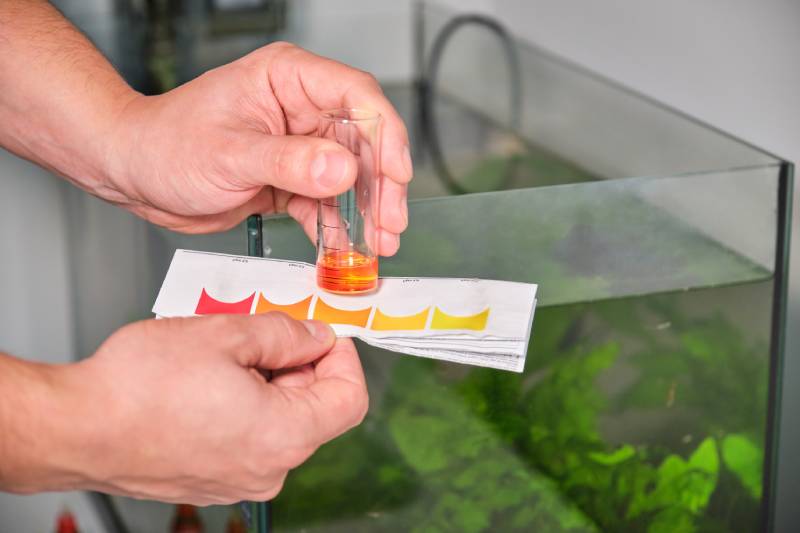
4. Adapting To a New Environment
All plants will need to adapt to their new environment, and you might lose a few of the aquarium leaves in the process. This adjustment period can cause the aquarium plants to turn brown within a few days of being introduced into an aquarium, and the plant will begin adapting to the new water conditions, such as the temperature, pH, and parameters of the water.
Diatoms (brown algae) in new aquariums can also cause fluffy brown spots to settle on the leaves, which can affect how much light the plant receives. These brown diatoms can make it seem like your aquarium plants have brown leaves, and it is common in aquariums where the water parameters of ammonia and nitrate are unstable.
There isn’t much you can do to fix a plant that is adapting to its new environment besides preparing and planting the roots in the substrate properly. You will need to make sure that the water conditions and parameters are suitable for the type of plant you have chosen and allow the plant to settle into the aquarium and new water conditions.
Ensure that the aquarium has undergone the nitrogen cycle before placing your plants inside and avoid keeping freshwater plants in a saltwater aquarium, and vice versa.
5. Low Carbon levels
Aquarium plants need carbon dioxide (CO2) for photosynthesis, so low levels of CO2 in the aquarium can have the same effects as a light deficiency. Your plant’s leaves and stems may begin turning brown if there is not enough CO2 available in the aquarium, usually in a heavily planted aquarium, or in an aquarium with few live inhabitants such as fish and invertebrates that produce carbon dioxide.
Fortunately, this can be easy to fix.
You can either use a liquid supplement or a CO2 diffuser system in your aquarium to increase the amount of CO2 available. Keeping the lights off during the night if you have fish and invertebrates can also increase the amount of CO2 in the aquarium by the plants and fish respiration.
Take caution when adding excess CO2 into the aquarium with fish or invertebrates, as an overdose of CO2 may harm them.
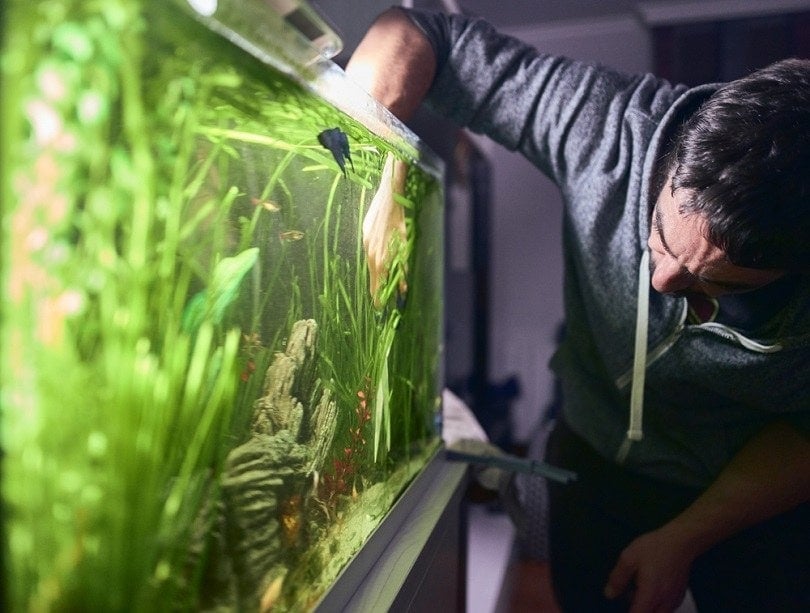
6. Planting Issues
Not all plants should be buried in the substrate, and some types of plants will fail to thrive if their roots are planted in the wrong substrate. This is true for plants such as hornwort, java moss, frogbit, and duckweed. Burying these plants or their roots can affect their growth and health, as these plants get their nutrients from the water column and not from the substrate.
If you were to bury the plant’s stems or leaves, it will block the amount of light they receive, and the plant will begin to die. Always research the specific care requirements of the type of plants you plan to keep in your aquarium, so you know whether to leave it floating or attach it to driftwood or rocks.
Other planting issues can occur if you use gravel or sandy substrates that do not hold a lot of nutrients for the plants or have big gaps between the substrate (like with gravel) which causes parts of the plant’s root to be exposed.
Ensure that you are using a compatible substrate with the plants you are growing in your aquarium. Add a decent layer of substrate in the aquarium that covers the plant’s roots without exposing them, while also weighing the plant down so it doesn’t float.
If you are keeping a species of plant that doesn’t need to be planted in the substrate, float it or attack it to rocks or driftwood instead.
Final Thoughts
Growing aquarium plants can be rewarding to keep, and there are many benefits to having plants in your aquarium for the live inhabitants and the water quality.
Some plants will be more sensitive than others, which is why they can turn brown when even the slightest problem occurs, while other hardier aquarium plants are more tolerant which means that you will have more time to rectify the problem before ruining the look of the whole plant. We all want our aquarium plants to look lush and healthy, so fixing the problem before it worsens can help save your affected plants.
Featured Image Credit: Nuzaa, Shutterstock

